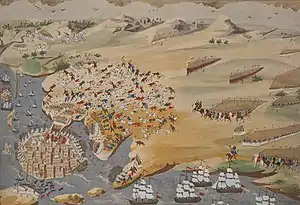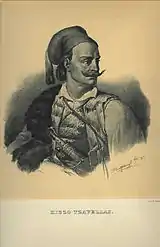Second Siege of Missolonghi
The Second Siege of Missolonghi was a second attempt by Ottoman forces to capture the strategically located port town of Missolonghi during the third year of the Greek War of Independence (1823). The second siege is usually ignored however, and the name is often applied to the greater siege of 1825–1826.
| Second Siege of Missolonghi | |||||||
|---|---|---|---|---|---|---|---|
| Part of the Greek War of Independence | |||||||
 | |||||||
| |||||||
| Belligerents | |||||||
|
|
| ||||||
| Commanders and leaders | |||||||
|
Konstantinos Metaxas Kitsos Tzavelas | Mustai Pasha Bushatli | ||||||
| Strength | |||||||
| 3,500 men[1] | unknown | ||||||


Background
After the first unsuccessful attempt to take the town in 1822, another expedition to western Central Greece was undertaken by Mustai Pasha of Shkoder. Mustai proceeded through the city of Trikala to Karpenisi, where a first Greek attempt to stop his advance resulted in the Battle of Karpenisi. During this battle, the Albanian casualties were 1,000 troops, but the Greeks lost their commander, Markos Botsaris. The second unsuccessful Greek attempt to stop Mustai at Mount Kaliakouda, on 29 August 1823, resulted in 200 Greek casualties.[2]
Siege
At 17 September the Albanian army was joined by Omer Vrioni and his troops. The two pashas decided to cooperate and siege Missolonghi and Aitoliko, an island which controlled the seaways of the Missolonghi lagoon.[3] The Albanian army arrived before Missolonghi and began the siege on 20 September with a bombardment of Aitoliko. The subsequent attack on Aitoliko failed however. Thousands of cannonballs were fired against the island and only a few of them found their target.[4] [5]
On 17 November, Ottoman food supplies were seized by 250 Souliotes under command of Kitsos Tzavelas.[6] Soon, inside the Albanian camp, clashes between Ghegs and Mirdites started happening, due to the lack of food.[7]
Meawhile rumors arrived that the Ottoman campaign in Eastern Central Greece had failed and damaged the moral of the siegers. As a result of food shortages and disease, on 20 November Mustai Pasha lifted the siege, withdrew and retreated to North Albania.[8] The siege had happened nearly winter, so its end was a matter of time by its beginning.[9][10][11][12]
Aftermath
Missolonghi remained under Greek control. Its resistance achieved wider fame when Lord Byron arrived there, dying in the town of fever in April 1824. The city was besieged for a third and final time, resisting both Ottoman and Egyptian armies for almost a year, until its final fall on April 10, 1826.
References
- Δημήτρη Φωτιάδη,Ιστορία του 21,ΜΕΛΙΣΣΑ,1971,τομ.Β,σελ.352
- Μεταξά Κώστα,Ιστορικά Απομνημονέυματα εκ τής Ελληνικής Επανασταστάσεως ,Αθήνα 1878 (εκδ.Β, Τσουκαλά 1956),σελ.96,97
- Paparigopoulos, K, History of the Greek Nation (Greek edition), vol. 6, p. 108
- Paparigopoulos, K, History of the Greek Nation (Greek edition), vol. 6, p. 108
- Δημήτρη Φωτιάδη,Ιστορία του 21,ΜΕΛΙΣΣΑ,1971,τομ.Β,σελ.352
- Μεταξά Κώστα,Ιστορικά Απομνημονέυματα εκ τής Ελληνικής Επανασταστάσεως ,Αθήνα 1878 (εκδ.Β, Τσουκαλά 1956),σελ.107
- Paparigopoulos, K, History of the Greek Nation (Greek edition), vol. 6, p. 108
- Paparigopoulos, K, History of the Greek Nation (Greek edition), vol. 6, p. 108
- Paparigopoulos, K, History of the Greek Nation (Greek edition), vol. 6, p. 108
- Δημήτρη Φωτιάδη,Ιστορία του 21,ΜΕΛΙΣΣΑ,1971,τομ.Β,σελ.353
- Κουτσονίκα Λ.,Γενική Ιστορία της Ελληνικής Επαναστάσεως ,Αθήνα 1863-1864 (εκδ.Β, Τσουκαλά 1956) σελ.186
- Douglas Dakin,The Unification of Greece 1770-1923,p.83, ISBN 960-250-150-2
Sources
- Δημήτρη Φωτιάδη,Ιστορία του 21,ΜΕΛΙΣΣΑ,1971,σελ.350-353.
- Μεταξά Κώστα,Ιστορικά Απομνημονέυματα εκ τής Ελληνικής Επανασταστάσεως, Αθήνα 1878 (εκδ.Β, Τσουκαλά 1956),σελ.96,97,107,111
- Κουτσονίκα Λ.,Γενική Ιστορία της Ελληνικής Επαναστάσεως, Αθήνα 1863-1864 (εκδ.Β, Τσουκαλά 1956) σελ.186